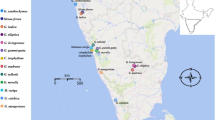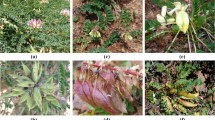Abstract
In India, the genus Alysicarpus (Fabaceae) is represented by approximately 18 species and seven varieties. It includes some species of considerable economic importance, including two of therapeutic value. The species of this genus are difficult to identify because of overlapping morphological characters. Moreover, it becomes difficult to establish the botanical identity of a herbal medicine available in powdered/fragmented form. In the present study, DNA barcoding was used to identify 42 accessions belonging to 15 species of Alysicarpus and two varieties. The DNA regions that were tested as potential barcodes were matK (Maturase K), rbcL (Rubisco Large Sub-unit), rpoC1 (RNA Polymerase-β subunit, the main catalytic subunit) and nrITS (Nuclear Ribosomal Internal Transcribed Spacer). In BLAST search on National Centre for Biotechnology Information (NCBI), ITS and rpoC1 sequences best matched with the respective sequences of species of other genera belonging to the family Fabaceae with less than 100% similarity, as no corresponding sequences of any Alysicarpus species were available. The rbcL and matK sequences had first match, with the respective sequences of Alysicarpus species, however, with less than 100% similarity. Among the loci tested, ITS alone discriminated all species on the basis of genetic distance as well as phylogenetic tree methods.





Similar content being viewed by others
References
Ali MA, Gyulai G, Hidvégi N, Kerti B, Al Hemaid FM, Pandey AK, Lee J (2014) The changing epitome of species identification—DNA barcoding. Saudi J Biol Sci 21:204–231
Altschul SF, Gish W, Miller W, Myers EW, Lipman DJ (1990) Basic local alignment search tool. J Mol Biol 215:403–410
Babbar SB, Raghuvanshi S, Singh HK, Parveen I, Malik S (2012) An overview of the DNA barcoding of plants. Phytomorphology 62:69–99
Baker JG (1876) Leguminosae. In: Hooker F (ed) Flora of British India, vol 2. Reeve & Co., London
Bell JR (2008) A simple way to treat PCR products prior to sequencing using ExoSAP-IT. Biotechniques 44:834
CBOL Plant Working Group (2009) A DNA barcode for land plants. Proc Natl Acad Sci USA 106:12794–12797
Chandrashekar KR, Sandhyarani S (1994) Differences in chemical composition of Alysicarpus vaginalis L. (DC.) growing in saline and non-saline habitats Biol. Plant 36:139–143
Chase MW, Cowan RS, Hollingsworth PM, van den Berg C, Madrinan S, Petersen G, Seberg O, Jorgsensen T, Cameron KM, Carine M, Pedersen N, Hedderson TAJ, Conrad F, Salazar GA, Richardson JE, Hollingsworth ML, Barraclough TG, Kelly L, Wilkinson M (2007) A proposal for a standardized protocol to barcode all land plants. Taxon 56:295–299
Chavan S, Sardesai MM, Pokle DS (2012) Alysicarpus sanjappae (Leguminosae: Papilionoideae), a new species from the Western Ghats of India. Kew Bull 68:1–4
Chen S, Yao H, Han J, Liu C, Song J, Shi L, Zhu Y, Ma X, Gao T, Pang X, Luo K, Li Y, Li X, Jia X, Lin Y, Leon C (2010) Validation of ITS2 region as a novel DNA barcode for identifying medicinal plant species. PLoS One 5:e8613
Desvaux NA (2013) Précis des caracteres de plusiers genres de la famile des Leguminseuses plants. J Bot Appl Agric Pharm Méd Arts 2:118–125
Endo Y, Ohashi H (1990) New distinctions between Alysicarpus vaginalis and A. ovalifolius (Leguminosae). Nat Hist Res Chiba no 1:43–48
Fazekas AJ, Burgess KS, Kesanakurti PR, Graham SW, Newmaster SG, Husband BC, Percy DM, Hajibabaei M, Barrett SCH (2008) Multiple multilocus DNA barcodes from the plastid genome discriminate plant species equally well. PLoS One 3:e2802
Ford CS, Ayres KL, Toomey N, Haider N, Stahl JVA, Kelly LJ, Wikstrom N, Hollingsworth PM, Duff RJ, Hoot SB, Cowan RS, Chase MW, Wilkinson MJ (2009) Selection of candidate DNA barcoding regions for use on land plants. Bot J Linn Soc 159:1–11
Gholami A (2015) Biology of Alysicarpus monilifer (L.) DC.: an important medicinal plant. Med Plants 7:248–251
Gholami A, Pandey AK (2016a) Alysicarpus gautalensis (Leguminosae: Desmodieae), a new species from Maharashtra, India. Phytotaxa 266:141–145
Gholami A, Pandey AK (2016b) Alysicarpus poklianus (Fabaceae, Desmodieae), a new species from India. Phytokeys 68:117–124
Gholami A, Pandey AK, Ansari AA (2016) Critical notes on Alysicarpus monilifer (L.) DC. [Leguminosae: Desmodieae] and its allies. Pleione 10:71–79
Gholami A, Subramaniam S, Geeta R, Pandey AK (2017) Molecular systematics of Indian Alysicarpus (Fabaceae) based on analyses of nuclear ribosomal DNA sequences. J Genetics 96:353–363
Gielly L, Taberlet P (1994) The use of chloroplast DNA to resolve plant phylogenies: noncoding versus rbcL sequences. Mol Biol Evol 11:769–777
Hall TA (1999) BioEdit: a user-friendly biological sequence alignment editor and analysis program for Windows 95/98/NT. Nucl Acids Symp Ser 41:95–98
Hollingsworth PM (2011) Refining the DNA barcodes for land plants. Proc Natl Acad Sci USA 108:19451–19452
Kumari KM, Rao BG, Padmaja V (2012) Role of vitexin and isovitexin in hepatoprotective effectof Alysicarpus monilifer Linn. Against CCL4 induced hepatotoxicity. Phytopharmacology 3:273–285
Li DZ, Gao LM, Li HT, Wang H, Ge XJ, Liu JQ, Chen ZD, Zhou SL, Chen SL, Yang JB, Fu CX, Zeng CX, Yan HF, Zhu YJ, Sun YS, Chen SY, Zhao L, Wang K, Yang T, Duan GW (China Plant BOL Group) (2011) Comparative analysis of a large dataset indicates that internal transcribed spacer (ITS) should be incorporated into the core barcode for seed plants. Proc Natl Acad Sci USA 108: 19641–19646
Mabberley DJ (2009) Mabberley’s Plant Book. Cambridge University Press, Cambridge
Pang X, Song J, Zhu Y, Xie C, Chen S (2010) Using DNA barcoding to identify species within Euphorbiaceae. Planta Med 76:1784–1786
Parveen I, Singh HK, Raghuvanshi S, Pradhan UC, Babbar SB (2012) DNA barcoding of endangered Indian Paphiopedilum species. Mol Ecol Resour 12:82–90
Pedley L (2001) Alysicarpus (Leguminosae: Desmodieae) in Australia: a taxonomic revision. Austrobaileya 6:107–116
Pokle DS (2002) Synopsis of Alysicarpus Desv. in India, In: Perspectives of Plant Biodiversity, edited by Das AP (Bishen Singh Mahendra Pal Singh, Dehradun) 471–481
Pramanik A, Thothathri K (1986) On the status of Desmodiastrum Prain (Fabaceae). J Indian Bot Soc 65:373–379
Ren BQ, Xiang XG, Chen ZD (2010) Species identification of Alnus (Betulaceae) using nrDNA and cpDNA genetic markers. Mol Ecol Resour 10:594-605
Sanjappa M (1992) Legumes of India. Bishen Singh Mahendra Pal Singh. Dehra Dun, India
Santapau H, Henry AN (1973) A dictionary of flowering plants in India. CSIR, New Delhi
Sass C, Little DP, Stevenson DW, Specht CD (2007) DNA Barcoding in the Cycadales: testing the potential of proposed barcoding markers for species identification of Cycads. PLoS One 2:e1154
Singh HK, Parveen I, Raghuvanshi S, Babbar SB (2012) The loci recommended as universal barcodes for plants on the basis of floristic studies may not work with congeneric species as exemplified by DNA barcoding of Dendrobium species. BMC Res Notes 5:42
Starr JR, Naczi RFC, Chouinard BN (2009) Plant DNA barcodes and species resolution in sedges (Carex, Cyperaceae). Mol Ecol Resour 9:151–163
Tamura K, Stecher G, Peterson D, Filipski A, Kumar S (2013) MEGA 6: Molecular evolutionary genetics analysis version 6.0. Mol Biol Evol 30:2725–2729
The Plant List (2013) Version 1.1. Published on the Internet; http://www.theplantlist.org/ Accessed 28 Aug 2019
van Meeuwen MS, Steenis van CGGJ, Stemmenik J (1961) Preliminary revisions of some Mayaysian Paplionaceae II. Alysicarpus Desv Reinwardtia 6:86–89
Verdcourt B (1974) Summary of Leguminosae—Papilionidene—Hedysarae (sensu lato of flora Zambesrana. Kirkia 9:545–546
White TJ, Bruns T, Lee S, Taylor JW (1990) Amplification and direct sequencing of fungal ribosomal RNA genes for phylogenetics. In: PCR Protocols: A Guide to Methods and Applications. Innis MA, Gelfand DH, Sninsky JJ, White TJ (Eds). Academic Press, New York. pp. 315–322
Acknowledgements
The financial support received by AKP and SBB in the form of R & D projects and DST-PURSE Grant from the University of Delhi are gratefully acknowledged. We are thankful to Profs S.R. Yadav, D.S. Pokle and Milind Sardesai, and Dr. Manoj Lekhak for their help rendered in the collection of plants. Thanks are due to Dr Paramjit Singh, Director, Botanical Survey of India, for permission to consult BSI herbaria.
Author information
Authors and Affiliations
Corresponding author
Ethics declarations
Conflict of interest
The authors declare that there is no conflict of interest.
Additional information
Publisher's Note
Springer Nature remains neutral with regard to jurisdictional claims in published maps and institutional affiliations.
Rights and permissions
About this article
Cite this article
Gholami, A., Malik, S., Dhabe, A.S. et al. DNA barcoding of Indian Alysicarpus (Fabaceae): ITS alone distinguishes species. Vegetos 33, 592–600 (2020). https://doi.org/10.1007/s42535-020-00144-3
Received:
Revised:
Accepted:
Published:
Issue Date:
DOI: https://doi.org/10.1007/s42535-020-00144-3




